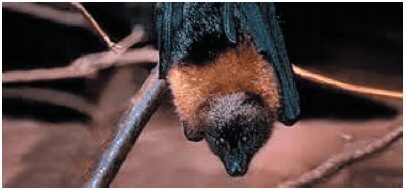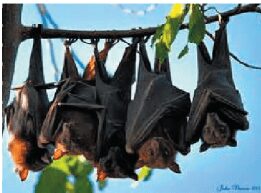1. Have A Happy, Blessed ave A Happy, Blessed And Safe Thanksgiving ! Be Mindful Of All Of The Good That You Do, And All Of The Good That Comes Your Way!

2. Bats Use Weighty Wings To Land Upside Down. Compared to birds and insects, bats have heavy wings for their body size. Those comparatively cumbersome flappers might seem a detriment to maneuverability, but new research shows that bats’ extra wing mass makes possible a quintessential bit of aerobatics: the ability to land upside down.
“Bats land in a unique way,” said Sharon Swartz, a biologist at Brown University who was a senior author of the new research along with Kenny Breuer from Brown’s School of Engineering. “They have to go from flying with their heads forward to executing an acrobatic maneuver that puts them head down and feet up. No other flying animal lands the same way as bats do.” But exactly how they are able to generate the forces necessary to perform those maneuvers hadn’t been clear. “When they come in to land they’re not moving very fast, which makes it hard to generate the aerodynamic forces needed to reorient themselves,” Breuer said. “So the question is, how do bats get themselves in position to land?”

Using a special flight enclosure, high-speed cameras and some sophisticated computer modeling, the researchers showed that it has a lot to do with wing mass and inertia. Bats’ wings are heavy, hand-like assemblages of bone, muscles, joints, tendons and skin. By throwing that extra wing weight around in very precise ways, bats generate inertial forces in order to reorient themselves, rather than relying on the aerodynamic forces generated by pushing against the air. It’s similar, Breuer says, to the way high divers shift their weight to perform flips and twists, or the way cats reorient themselves to land feet-down when they fall.
The videos showed that as the bats approach the ceiling, they retract one of their wings ever so slightly toward their bodies, while flapping the other at full extension. With each wing beat in that asymmetric configuration, the bats rotate a half turn, helping to put them in position to meet the mesh feet first. In subsequent trials, the researchers removed the mesh from the ceiling, leaving the bats nothing to grab on to. Video of those trials showed that, after attempting to land, the bats performed a similar rolling maneuver using their wings in order to reorient themselves for forward flight.

The researchers then used computer simulations to confirm that the effect they were seeing was due to inertia rather than aerodynamics. They used motion capture to record the bats’ movements and then replayed those movements through a computer simulation in which the effects of different forces could be switched on and off. When the simulation was run with aerodynamic forces turned off, the virtual bats were still able to recreate the motion of the real ones.
The research sheds light on the basic biology that helps bats fly and land the way they do, but also may be useful in the development of human-made flying machines. Source: Brown University The researchers then used computer simulations to confirm that the effect they were seeing was due to inertia rather than aerodynamics. They used motion capture to record the bats’ movements and then replayed those movements through a computer simulation in which the effects of different forces could be switched on and off. When the simulation was run with aerodynamic forces turned off, the virtual bats were still able to recreate the motion of the real ones.
The research sheds light on the basic biology that helps bats fly and land the way they do, but also may be useful in the development of human-made flying machines
3. The History Of Thanksgiving. The history of first Thanksgiving as a holiday goes back to 1620. Late that year, the Mayflower, a small ship for ocean crossings, left England with over 100 passengers onboard. Some of them sought religious freedom in the new world and others simply were drawn by stories of the prosperity once could achieve in America. The journey to the new world lasted over two months. When they arrived, they found themselves well off course, near the tip of Cape Cod. They had been navigating for the Hudson River. They setup the colony at Plymouth on the other side of the bay over a month later. The settlers were ill prepared for the harsh New England winter and by the time spring came, they were down to about half of their original compliment.
That spring they met a Native American who spoke English. He introduced them to Squanto; the famous English speaking Indian who helped the settlers stay alive. He showed the otherwise hopeless settlers how to fish and hunt as well as how to grow corn and tell edible plants from poisonous ones. Squanto introduced the settlers to a friendly local tribe called the Wampanoag. With the help of the Native Americans the settlers prospered and later that year, in November of 1621 the settlers were ready to celebrate the successful harvest of their first crop of corn. The settlers invited many of their Indian allies to the party. The celebration of that first harvest lasted 3 days and many dishes both from the settlers as well as Native American cuisine.
The celebration, at the time, had a very obvious patriotic and anti-English subtext. People began celebrating Thanksgiving Day more regularly. However, depending on where you were, the day of the celebration might be different. In 1817, New York was the fi rst state to adopt Thanksgiving as an official holiday. By the time the Civil War erupted in the 1860’s, every state had also made Thanksgiving a state holiday. In 1863, President Abraham Lincoln declared a national day of Thanksgiving on the last Thursday of November. Since that time, every president has issued a Thanksgiving Day Proclamation every Thanksgiving, declaring it to be a national day of thanks. In 1939, President Franklin Roosevelt declared that the Thanksgiving would be on the third Thursday in November. Congress approved that declaration two years later in 1941.
It is no secret that most Thanksgiving Day traditions revolve around food. Indeed, the turkey is the symbol It is no secret that most Thanksgiving Day traditions revolve around food. Indeed, the turkey is the symbol of Thanksgiving. Wild turkeys are still quite common in many parts of the United States, so most historians of Thanksgiving. Wild turkeys are still quite common in many parts of the United States, so most historians would concede that turkey was probably on the menu. However, there were probably lots of other types would concede that turkey was probably on the menu. However, there were probably lots of other types of meat on the menu too, like venison and pork. What is more telling is what was missing from that fi rst of meat on the menu too, like venison and pork. What is more telling is what was missing from that first Thanksgiving. There were probably very few if any vegetables at the Thanksgiving feast.
The Thanksgiving holiday has come a long way from its humble beginnings. The Thanksgiving holiday has come a long way from its humble beginnings. Thanksgiving was celebrated during the American Revolution at least once Thanksgiving was celebrated during the American Revolution at least once and George Washington declared a day of thanksgiving in 1789 to mark and George Washington declared a day of thanksgiving in 1789 to mark the end of the Revolutionary War. The holiday was celebrated by different the end of the Revolutionary War. The holiday was celebrated by different states at different times for many years to follow. Source: http://historyofthanksgiving.net/
Squanto, also known as Tisquantum, was a Native American of the Squanto, also known as Tisquantum, was a Native American of the Patuxet tribe who acted as an interpreter and guide to the Pilgrim settlers at Plymouth during their first winter in the New World. Squanto was settlers at Plymouth during their first winter in the New World. Squanto was born circa 1580 near Plymouth, Massachusetts. Little is known about his early life. In 1614, he was kidnapped by English explorer Thomas Hunt, who brought him to Spain where he was sold into slavery. napped by English explorer Thomas Hunt, who brought him to Spain where he was sold into slavery. Squanto escaped, eventually returning to North America in 1619.region, where he became an interpreter Squanto escaped, eventually returning to North America in 1619.region, where he became an interpreter and guide for the Pilgrim settlers at Plymouth in the 1620s. He died circa November 1622 in Chatham, Massachusetts. Source: www.biography.com/people/squanto-9491327
